A day for the planet
CLEANING THROUGHOUT THE ISLAND
May 30 from 10am to 2pm
Come join @creativesfortheplanet in Santos Ibiza to support “A DAY FOR THE PLANET” in which he is calling all the people of Ibiza to go out and clean their environment as a symbol of mutual responsibility to take care of our planet!
See you on May 30 in Santos Ibiza at 10 am to start the collection at the beach d’en Bossa.
Put on your gloves, go outside, collect all the trash you can and enjoy some musical and artistic events after taking your trash to one of the collection points.
Everything that happens in A Day For The Planet, all the action, art and mutual care will be collected, filmed, photographed and combined in an online magazine: The Vision.
So send your photo to @creativesfortheplanet with your garbage collected and its estimated weight. “We want you and your action to appear in the magazine and on social media.”
Stay tuned to the map …
It will show the collection points, as well as the cleaning crews and all the other fun things that will happen.
Check out the Gofundme campaign from @creativesfortheplanet, they would greatly appreciate your support:
Together, For The Planet!
Art Decó
If Summer were an Architectural Style
By Laura Martínez
Photos: Phillip Pessar / Amaury Laporte / Lazy Llama / Carsten Tilbach / Sergio Santos
When thinking about the Art Deco concept, a whole potpurri of ideas come to mind: geometric curves, neon lights, a Lana de Rey song, pastel colours, Leonardo Di Caprio wearing a tuxedo in The Great Gatsby, winking while he raises his Martini, and of course, Miami. If you thought of these things then you’re on the right track; Art Deco is all this and more. It’s pure eclecticism.
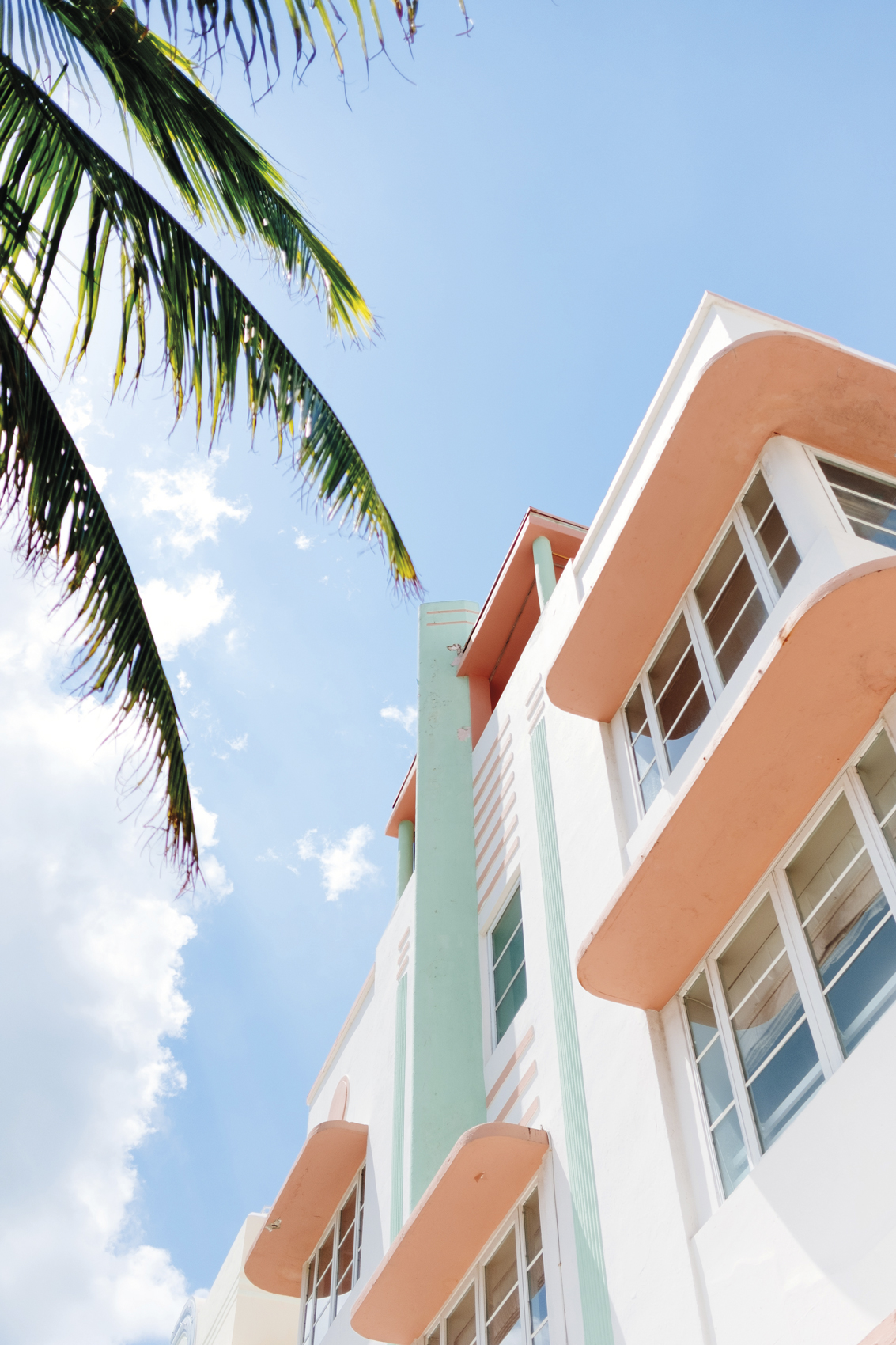
This architectural movement, which could well be a modern version of neoclassicism, had its heyday in the 1920s and 1930s, between the two World Wars. Its greatest expression is in Miami’s Art Deco Historic District – which is also the first 20th century neighbourhood to be listed in the National Register of Historic Places and protected by the Miami Design Preservation League – comprising a whopping 800 buildings and structures built between 1923 and 1943.
The largest concentration of Art Deco buildings in the world stretches along Ocean Drive and Washington Avenue to Collins Street. A magnetism that is built on evocative hotel names (Marlin, Leslie, Colony, Raleigh…) with sleek, minimalist typography clad in neon and vibrant colours, inviting you to imagine endless nights, dancing the Charleston and smoking with a Widmann cigarette holder, wielded by stylish women with a pistol hidden in their stockings.
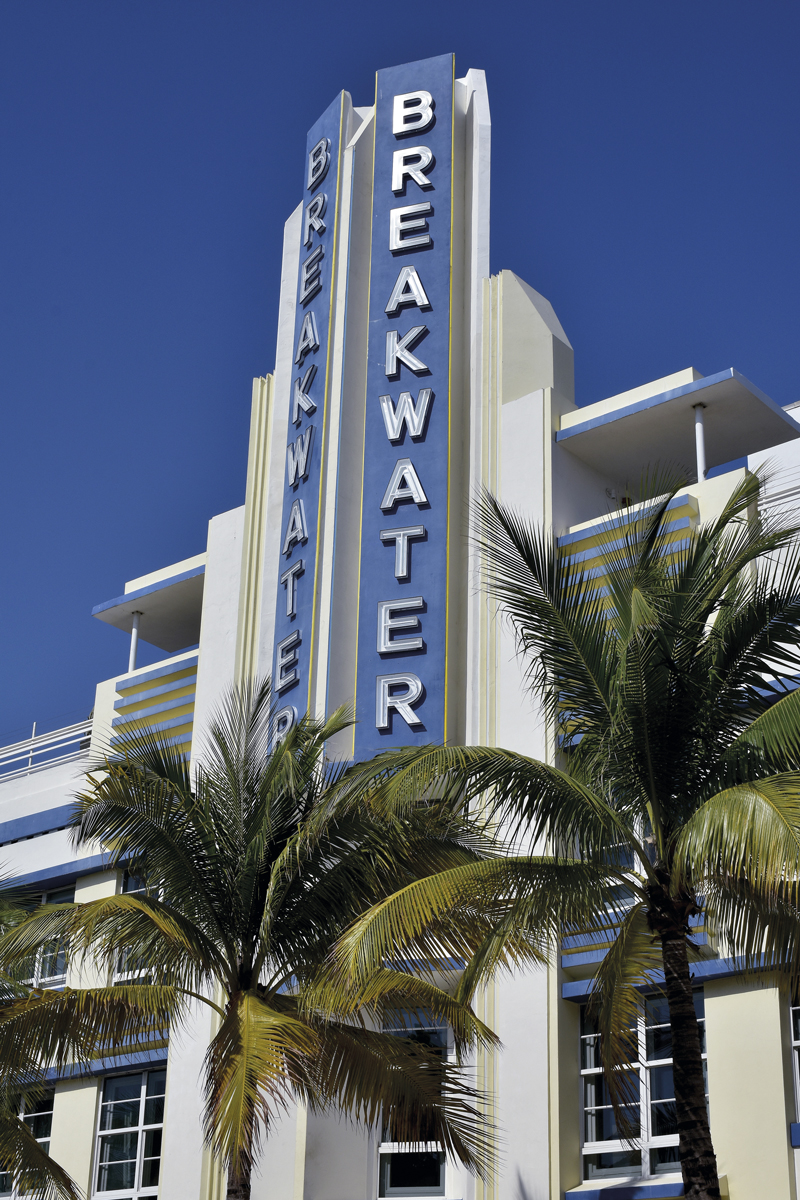
One of the most emblematic is the Park Central Hotel (640 Ocean Drive) by New York architect Henry Hohauser, who is also the architect behind many establishments in the so-called Magic City: Colony Hotel (736 Ocean Drive), The Cardozo (1300 Ocean Drive) and The Governor (21 Street).

But Art Deco was not born in South Beach (the Americans appropriated the idea and made it their own, like always), it is a monumentality borrowed from Ancient Egypt, the fractioned forms of Cubism, the geometrisation of Bauhaus, the electric lighting of Futurism, the colours of Fauvism – that provocative use of colour whose precursor was Henri Matisse – and voilà! These all coexist in harmony.
Art Deco is hedonistic, bourgeois, almost purely decorative. An ideal escape route for jazz and cocaine parties in the midst of the post-war period. The perfect counterpoint to the forced austerity after the First World War and the decadence after the Second. It is the artistic result of an era of great technological, political and social change, and that is why it is an almost incomprehensible mixture of elements that make this architectural style one of the most
recognisable and attractive in existence.

This hard-to-define amalgamation brought together the complete spectrum of the arts: decorative, graphic, architecture, jewellery, sculpture, industrial design, painting, cinema… in a maelstrom of shapes and colours that encompasses everything from gigantic skyscrapers to small objects, including such recognisable objects as the Academy Award (Oscars) statuette to the robot in Fritz Lang’s classic film, Metropolis (1927). It left his mark on everything that could be called aesthetic, influencing the culture of its time and proposing revolutionary new stylistic directions.
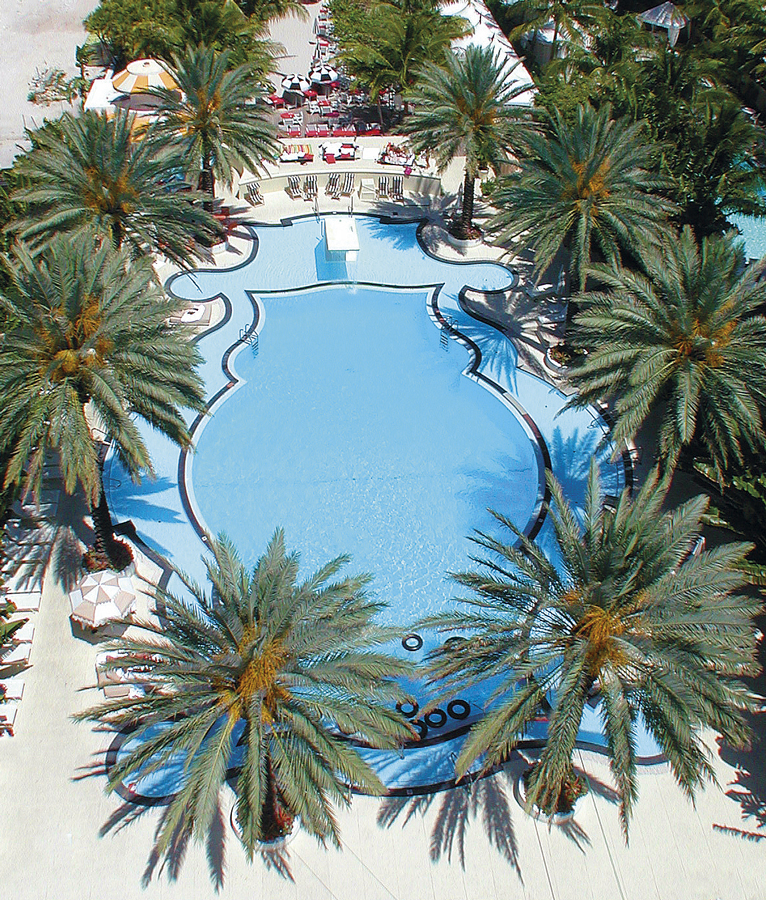
At Concept we like all that is out of the norm, and that is why Art Deco is the reference point that has inspired our hotels: Tropicana’s nods to MiMo (Miami Modern). Paradiso’s pastel pink colours and geometric shapes, Cubanito’s colourful façade. Art Deco encompasses art and detail like no other, and has once again been chosen, in its most classic and elegant version, for our new project: Grand Paradiso, a revolutionary breath of fresh air where summer never ends.
Music Legends in Ibiza
Ibiza, the music refuge
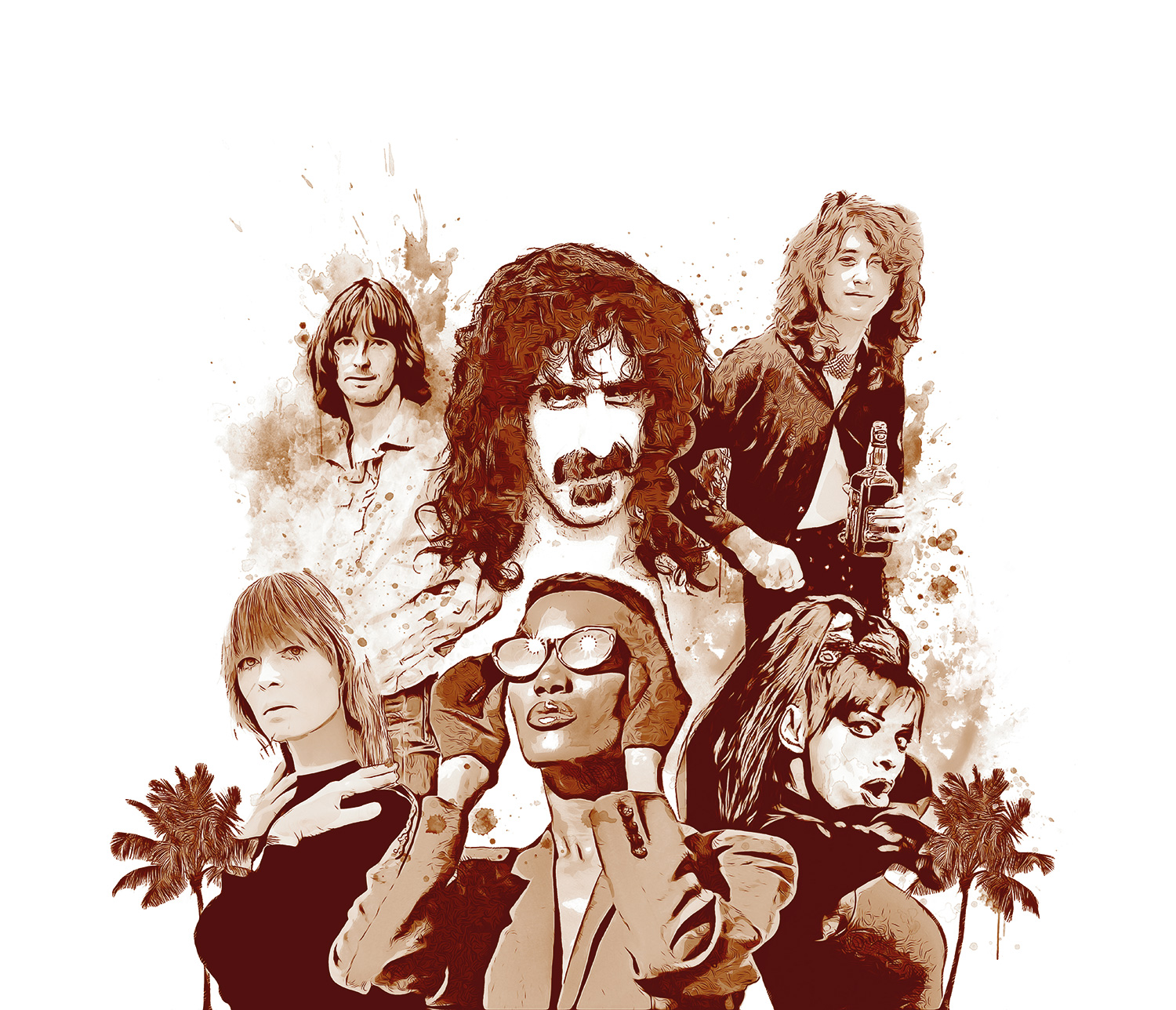
By Pablo Sierra
In the late 1960s, a shockwave of hippy love crossed the Atlantic to dock on European shores. Ibiza was one of the epicentres of an earthquake that questioned everything, but changed almost nothing except culture in general. Music: rock, folk, psychedelia, funk, punk, reggae and disco changed forever. A smörgåsbord of sounds provided the soundtrack for an island that became a refuge and source of inspiration for many artists until the nineties.
Christa Päffgen’s pale complexion contrasted with the darkness of a voice that illuminated avant-garde scene art scene half a century ago. A deep tone resonated from her voluptuous lips. This German singer’s overwhelming beauty captivated all who made her their muse. Andy Warhol was the first to fall under a spell, that also captivated the members of The Velvet Underground.
The international pop-rock scene quickly followed suit as Christa became Nico, the stage name she was given by a photographer. She became a singer-songwriter, model and actress, whose stunning, chiselled features ultimately brought her more sadness than joy. After touring on several low budget tours in the 80s, she wanted to get away from it all and went to Ibiza on holiday in 1988.
She loved riding her bike along the island’s rural roads and unfortunately, this is how she met her end. On 18th July she fell off her bike and hit her head on a rock, causing severe brain haemorrhage. Her friends said goodbye by playing her songs on a cassette tape at her funeral.
An artist who always had a pleasant relationship with God and Ibiza is Nina Hagen, another German whose dazzling performances raised the extravagance of operatic punk to the next level. Nina experienced an epiphany when experimenting with LSD, a moment that marked her destiny. She was nineteen years old when she heard a male voice mumbling, “Nina, I’m here. I will help you.” From then on her dogma consisted of a mixture of religion, spiritualism and a fervent belief in aliens.
The mother of punk decided to get married in Ibiza in 1987 to an 18-year old called Iroquois. Their wedding photo is one of the most original of all time: Nina with a cascade of red hair flowing down her back and Iroquois sporting a massive Mohican. The nuptials were crowned with a wild celebration of their love at Benirràs, an occasion that only a privileged few could attend. It’s quite possibly the most bizarre wedding that the island has ever known.
Grace Jones has graced Ibiza with two concerts, spanning different decades. The Jamaican diva had been the queen of New York in the late 70s, and ten years later at the peak of her powers, she performed in Ibiza. Jones was, and – still is – beautiful, artful, exotic and frighteningly wild. In 1988 she won over KU’s audience with a disco tour-de-force that saw her wear outfits that have influenced modern- day divas such as Lady Gaga and Rihanna. Jones’ physique – an androgynous and slender sculpture carved in ebony – did not go unnoticed when she moved around the island. There is an iconic photo of her sticking her tongue out at Carles Ribas’ camera while she walks the beach in the company of Tony Pike that particularly sticks in the memory. She made a triumphant return to the island in 2009, with a sold-out concert at Space Ibiza in 2009 that took the breath away. She literally was a Hurricane, the title of her first album in almost twenty years.
Another legend who didn’t want to miss the opportunity of getting a tan under Ibizan skies was Jimmy Page, a badass guitarist who led one of the most influential bands of all time: Led Zeppelin. They broke up in 1980 after the tragic death of drummer John Bonham, but Page continued to fly solo. Five years later he answered the siren call of Ibiza, where he played to at the Sun Power Festival, an idea that seemed good on paper but was, in reality, a complete failure. Accompanied by Chris Squire – the bass player from Yes, and Jason Bonham, son of John, they played three songs in front of a disappointing crowd of 1000 people (8000 tickets were put on sale).
If we are talking about guitar wizards then we have to mention Eric Clapton. The one-time member of Cream set sail for Ibiza from Cannes to star in a concert at the Bullring in August 1977. However, they hit some heavy weather and the resulting storm almost sunk their boat. The Mediterranean Sea may seem tame but it can be treacherous. If you have seen the scene in The Wolf of Wall Street where Jordan’s yacht sinks on the way to the Costa Azul can probably imagine what Eric’s voyage was like. It’s been said that Clapton’s boat bounced around the seas like a ball in a pinball machine. One of several people to be called the fifth Beatle because of a strong connection with George Harrison, he lived to tell the tale and appeared live in concert on 5th August 1977.
Frank Zappa, one of the stars of Ibiza ‘92 Festival, had a more relaxing time when he came over. His visit was quick, as fleeting as a comet that leaves an indelible trail in its wake before disappearing. Frank Zappa visited the island in summer 1989 (four years before dying of prostate cancer) but the island left a huge impression him, as seen in an immortal photo of Frank pointing his finger at the Es Vedrà islet, while stating: “”Ibiza is a fantastic island, here sex shines brighter than the sun.” No wonder this contemporary Renaissance man was so successful.
Legendary Hotels: The Chelsea
The Chelsea: A muse as an hotel
By Pablo Burgués
As well as being rich, famous and having the best hair out of all your modern buddies (together), there are two more things that Bob Marley, Patti Smith,Jimi Hendrix, Charles Bukowski, Uma Thurman, Dennis Hopper and Keith Richards have in common. First: they love (or loved) partying hard above all else. Second: they all found time in their helter-skelter schedules to check in for an extended stay at The Chelsea Hotel in New York.
Since opening in 1905 this charismatic building, situated between 7th and 8th Avenue, became the cultural and artistic epicentre for bohemian New Yorkers. Or in other words, a den of carnal desire and moral ruin where all types of artists and shady characters fell in to in search of inspiration (and that which wasn’t at all inspirational).
Many, many crazy tales have been told about what happened behind the red brick façade of The Chelsea, but as you surely have better things to do in Ibiza than read a magazine, we will give you a brief rundown of the hotel’s most (in)famous moments.
4th November 1953. Room 217 Dylan Thomas, the Welsh poet and author (the person from whom Bob Dylan took his stage name) died (according to legend) after drinking industrial quantities of alcohol laced with a quarter of morphine. And you think you’re hard by drinking vodka with Red Bull.
12th October 1978. Room 100 Sid Vicious, bass player with the Sex Pistols, got so fucked up on heroin that he supposedly stabbed his girlfriend, Nancy Spungen, to death.
I bet you’re thinking, “wow, drugs are really bad”. Well for your information painter Alphaeus Cole (another party animal) lived in The Chelsea during 35 years and died peacefully in his room, aged at 112 years and 136 days old. Therefore getting off your head is bad, but for some it is doesn’t make the slightest bit of difference.
We’re going to leave the juicy stories aside because The Chelsea is also famous for being a tremendously inspiring place, one of those magical establishments that are so full of energy that even someone completely out touch with music such as Louie Bega (Mambo No.5 has to be one of the worst crimes committed in the name of music) or anyone who ‘performs’ at Eurovision, would have been able to compose a hit. Great examples of songs written about the establishment include: Bob Dylan “Sad Eyed Lady of the Lowlands”, Jon Bon Jovi “Midnight in Chelsea”, The Stooges “We
Will Fall” and Ryan Adams “Hotel Chelsea Nights”.
Some superb films have also been shot or written at the hotel such as 91⁄2 Weeks, Sid & Nancy, Leon and 2001: A Space Odyssey.
The hotel’s sheets have also born witness to epic love stories between Jim Morrison and Nico or Leonard Cohen and Janis Joplin, an affair immortalised in his song “Chelsea Hotel #2”. Madonna, who was in her imperial, 80s temptress phase, also lived and shot her Sex book there, in Room 822.
The hotel was closed in July 2011 as it was taken over by new owners, supposedly for renovations that were due to last a year. More than 8 years later it still remains closed and covered with scaffolding, with approximately 50 tenants still living inside and multiple lawsuits and changes of ownership meaning an endless renovation process. So until it reopens, if you are a writer in search of inspiration, a musician looking for that killer riff or a mere mortal who wants to pay a sexual tribute to that special one that makes you hot, then check-in at Paradise Ibiza Art Hotel, The Chelsea of the Mediterranean.
Ibiza 92
Cuando Montserrat conoció a Freddie
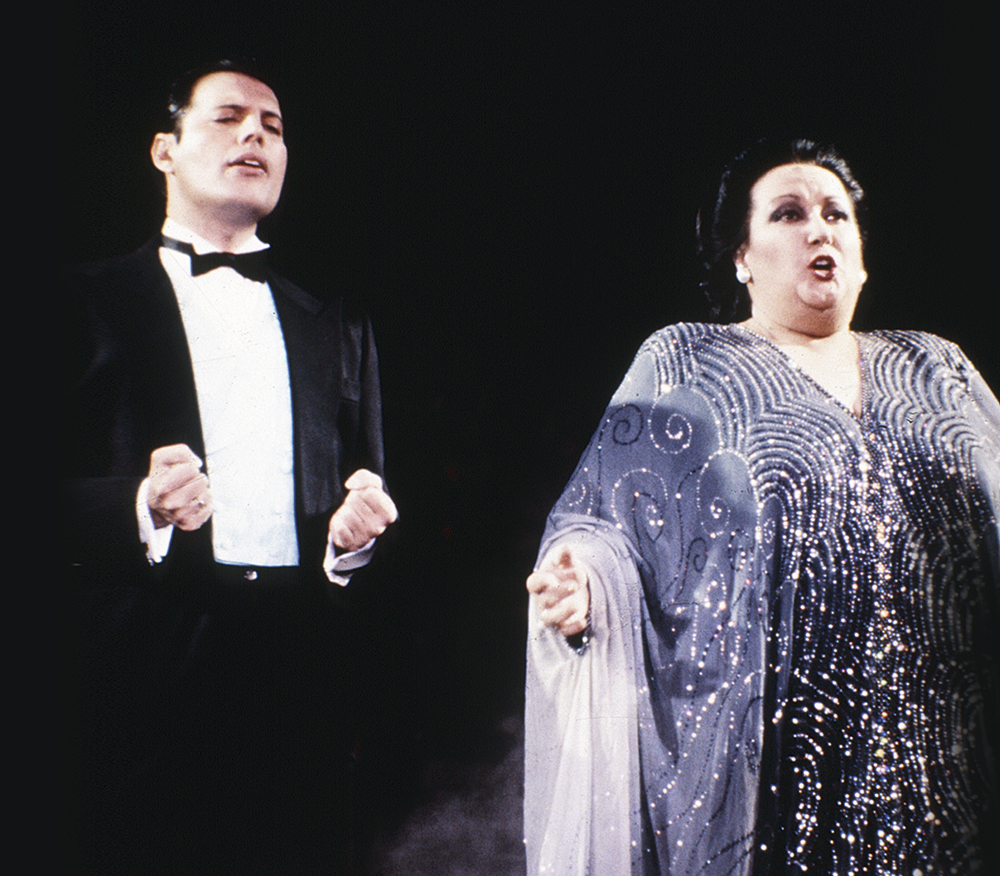
By Pablo Sierra
Photos courtesy of Juan Suárez
In the middle of that glorious decade known as the Eighties, Spain was taking firm steps towards becoming the modern society that we know today.
There was a hurry to take advantage of the opportunities that the Barcelona Olympic Games and the Seville Expo would provide. Music, and Ibiza, wasn’t about to get left behind. Pino Sagliocco, an Italian based in Ibiza, escaped the town of his birth, Mezzogiorno, to become one of the boldest promoters in the world. Based In Ibiza at the beginning of the 80s, Sagliocco was in the right place, at the right time, when he invented Ibiza’92.“What makes Pino Sagliocco great is his ability in thinking bigger, better and further than the rest of us mortals.
That’s what makes him unique and incomparable.” said Juan Suárez, one of the collaborators who worked with Pino on the festival, held in KU discotheque, that hosted concerts from la crème de la crème of the music world, between 1987 and 1990. Grace Jones, Spandau Ballet, Duran Duran, Mick Jones from The Clash, Chris Rea, El Último de la Fila, Hombres G, and Ramoncín were just some of the great names that played.
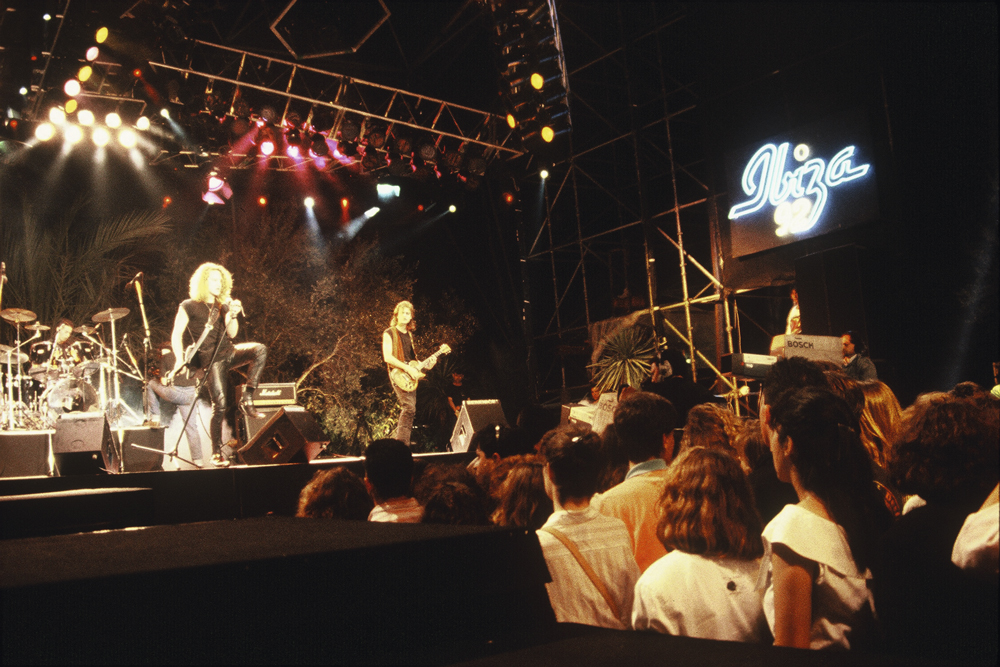
Frank Zappa attended the concerts and happily chatted to journalists and music lovers about how music was changing culture, something he unfortunately didn’t get to see himself due to his premature death in 1993. Suárez continued “Zappa was living proof that when superstars come to Ibiza they are so much more relaxed, because they get to escape their normal routine”.
Before Ibiza’92, Suárez had already been on the KU stage to present James Brown in concert (which was another Sagliocco production). The Godfather of Soul was in the twilight of his career, and although he gave the promoters a hard time with his extravagant requests, the music that Brother Brown delivered that night made the walls drip with soul. An incredible concert.
Before Ibiza’92, Suárez had already been on the KU stage to present James Brown in concert (which was another Sagliocco production). The Godfather of Soul was in the twilight of his career, and although he gave the promoters a hard time with his extravagant requests, the music that Brother Brown delivered that night made the walls drip with soul. An incredible concert.
Sagliocco’s wish came true on 30th May 1987, and was filmed by the cameras from state channel, Spanish Television, with two thousand people in the audience and a production that cost 300 million pesetas, a large amount of money at the time (equivalent to the annual salary of three footballers from Real Madrid or FC Barcelona, for example). Caballé, as journalist Jacinto Antón wrote in El País, was led by Freddie Mercury dressed in a tuxedo on to the stage and this image entered into the history of music and sports. Five years later the song was the official anthem of the Barcelona Olympic Games.
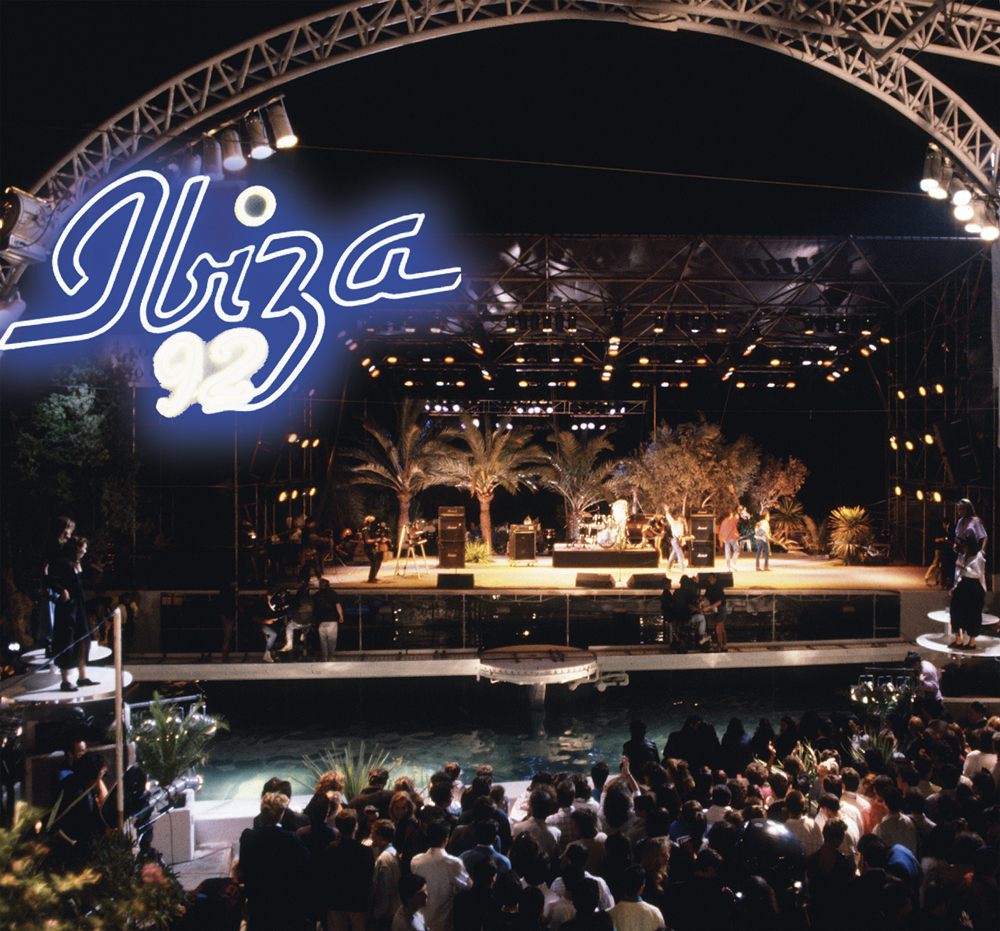
At a time when the internet was still a distant dream Suarez recalled that “you had to travel to London, Madrid, Barcelona, Los Angeles or the fashion capitals to hire the big artists. Negotiations and contracts were made by telex (note for millennials: the telex, or teletype, was a device that allowed to the sending of typed messages, an analogical fusion between the 19th telegraph and the 21st century WhatsApp, that thirty years ago, was very useful for war correspondents and event promoters to send stories or contracts to the other parts of the world).
This method was followed by fax and telephone. However the personal presence of the promoter was important because it gave credibility, economic guarantees and visibility for projects” The technical side of things was also a challenge. In the late Eighties, organising a festival on the island – the Sueños de Libertad festival is a recent example – was much more expensive and complex than organising it on the Spanish peninsula.
“Setting up a show on the island costs ten times more work, money, passion and effort than in any other part of the world. Back then there were no light or sound companies on the island that had the necessary equipment for a concert.
This meant having to bring in amplifiers, lights and sound equipment from outside of the island, and this made it very difficult to organise any concerts. You had to resort to playback at times, especially when it was recorded for television, for takes, repeats and so on. And some artists would only perform with playback because they loved it so much,” said Suarez.
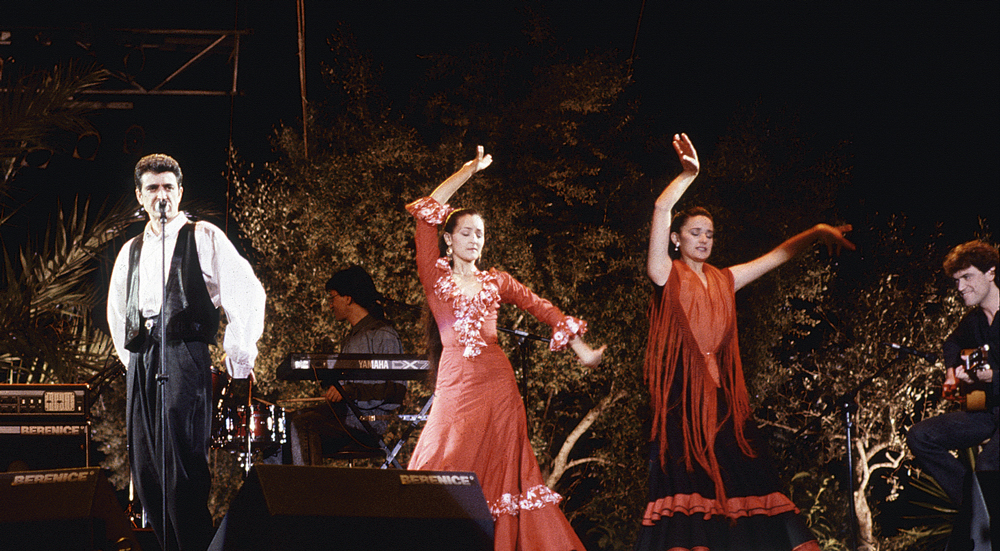
However, Suárez considers that “Ibiza’92 was a groundbreaking event, both visually and musically, it was well worth the effort”. “The island was then known as a destination for family tourism, or for the British, partying in Sant Antoni. The international broadcast of the festivals, and the number of well-known artists who performed, generated a new trend that turned the island into an unmissable destination for music and entertainment. Pino Sagliocco planted the seed of what Ibiza is now: the mecca of global electronic music “.
Legendary Hotels: The Mutiny
The Mutiny: Sex, drugs and a monkey with a Rolex
By Pablo Burgués
In the 1960s, Miami was a glorified retirement home where the wildest thing you could do was to participate in an illegal electric wheelchair race. However, the end of the 1970’s saw everything change, and this sunny haven of peace became one of the bloodiest and most violent cities in the USA.
What the hell happened? Well, a handful of drug traffickers from Cuba, Venezuela and Colombia came to the city with the “noble” aim of gaining control of the drug trafficking route in the southern United States. These people mostly let their guns do the talking, and pretty soon Miami became the city with the most homicides in the whole country. The coming and going of corpses became so extreme that the county morgue, having more dead bodies than they could handle, had to rent a refrigeration truck from Burger King. Grilled tastes better !!!
In the middle of this bloodbath was a paradisiacal place where peace and friendship reigned called The Mutiny. This hotel, halfway between The Playboy Mansion and Studio 54, was described by its owner, Burton Goldberg as “the place where anything could happen”… and, oh boy, did those thingthings happen!
Located in the Coconut Grove neighbourhood (South Beach), the place had 130 thematic rooms, with each one more and more extravagant, and it was the place to stay for the biggest and naughtiest stars on the planet: Paul Newman, Arnold Schwarzenegger, Led Zeppelin, Don Johnson, The Eagles, Fleetwood Mac and of course the original latin lover himself: Don Julio Iglesias.
Big as all these dudes and dudesses were, the guys who really ruled The Mutiny were the drug traffickers, who had by now turned the hotel into their personal operations centre. Through this Nar- Coworking passed some authentic legends of the chang such as El Perro, Super Papi, El Raspao and Mr Pablo Escobar himself. Although without a doubt the most ‘chingón’ of all was Mario Tabraeu.
It is said that this lovely human paid $25,000 to fill the bathtub in his room with Dom Perignon, and that he walked around with a chimpanzee who wore some gangster gold chains and a Rolex. It is rumoured that Tony Montana, the character played by Al Pacino in the film Scarface, is inspired on him (Mario Tabraeu, not the monkey).
For years The Mutiny’s installations were in international waters, a kind of free trade zone where the jet-set, the police and the narcos shared a table and happily did business. However, the bad guys begat more bad guys, and pretty soon it became a haven of hired assassins. The hotel stopped being cool and started to become very scary indeed and soon many of the hotel’s clients stopped going.
In 1981 a certain Miguel Miranda, a Santeria drug trafficker who used to drink the blood of slaughtered animals, murdered one of the hotel’s waitresses. Her body appeared days later in Key West, wrapped in one of The Mutiny’s bedsheets. This murder was the final blow for a business that was already in decline, and it finally closed its doors in 1984.
In the mid 1990’s the hotel was reopened by an important luxury hotel chain. It is still open today, but now there is no trace left of its decadent past and the wildest thing you could do on its grounds is snort a ginger detox juice.
Addicted To Art: Adda Gallery Ibiza
Adda Gallery Ibiza: abducted by urban art

By Pablo Sierra
There are calls that change your life. When Anna Dimitrova, gallery owner and cultural manager, picked up the phone, she did not know that a few months later she would be setting up an art gallery in Ibiza.
When she hung up the phone, this native of Bulgaria, educated in Morocco, and who currently commutes between Barcelona and Paris, was almost instantly convinced to take up the challenge posed to her: to be the artistic heart of Paradiso Ibiza Art Hotel.
–Two years ago Diana Kunst called me and said: “Would you like to open a gallery in Ibiza?” The idea tempted me a lot and, at that moment, I saw everything clearly. I visited the building, which in the future would be the hotel, and I found it impossible not to fall in love with Paradiso.
This is a great example of who Dimitrova is: she isn’t a person to hide her emotions and she doesn’t mind doing drastic turns if passion is behind the wheel. Until 2007 she was dedicated to the world of advertising and communication. From then on she applied her knowledge to branding, marketing and investing her time in what she really loved; art. She especially loves urban art and she said: “There has been an explosion in street art, a real boom, and it is increasingly recognised by a larger audience. It has created authentic fans who follow their favourite artists around the world, and know everything about them. People are very motivated to see this type of art exhibition”. She currently curates artists such as: Escif, Ebok, Levalet, Spok, Smithe, Nuria Mora and Sebas Velasco.
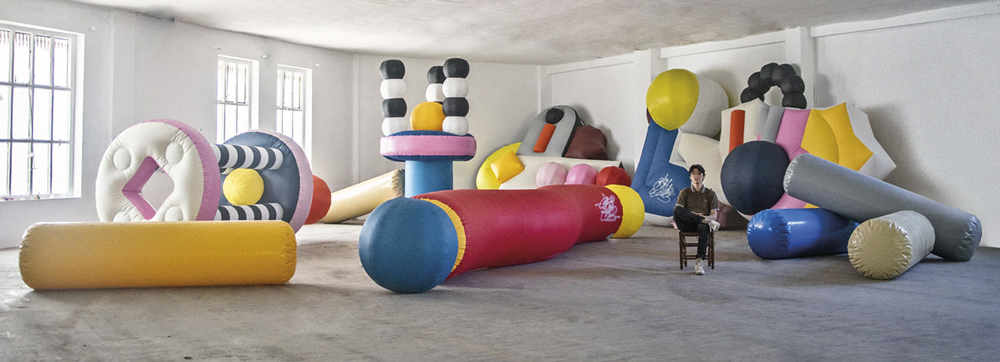
“Desde pequeña me obsesionan la cultura y el arte. Cuando crecí tuve cabeza para darme cuenta de que era bastante mejor organizando que dibujando”, dice Dimitrova. Nobulo y Adda son el fruto de su esfuerzo y de su gusto por la belleza transgresora. A través de sus dos proyectos produce exposiciones por todos los rincones del planeta. En las dos ciudades donde duerme la mayor parte de las noches dirige y gestiona, respectivamente, sendos espacios expositivos: Montana Gallery, en Barcelona, y Adda&Taxie, en París.

“Ever since I was young I have been obsessed with culture and art. When I grew up I realised that I was much better at organising than at drawing, “says Dimitrova. Nobulo and Adda are the fruit of her efforts, as well as her taste for transgressive beauty. She organises exhibitions in all corners of the world through these two projects. Anna currently directs and manages exhibitions in the two cities where she spends the majority of her time, precisely in Montana Gallery in Barcelona, and Adda & Taxie in Paris.
In 2018 Paradiso became a part of her working life, as the place where she has launched Adda Gallery Ibiza: “The risk of filling a hotel with art is that the works end up being simple decoration. This does not happen in Paradiso for a very simple reason: the gallery is independent from the hotel, and although it is separate, it is at the same time connected to the rest of the facilities. We nourish each other, but each zone maintains its personality.” For Dimitrova, that fact that each room is dedicated to a different artist, and that the lobby is a place where art experiences occur is something more than the hotel’s hallmark. It is the soul of Paradiso because “works of art transmit the energy and experiences of their creators in the space where they are exposed”.
The coloured pills of the young Catalan graffiti artist Abel Iglesias (in May and June 2019) and the wild fauna that the Madrid muralist Sabek (in July and August 2019) expresses in his art will be the two individual exhibitions hosted at Adda Gallery Ibiza this season. In September and October 2019, the 4th edition of the collective exhibition “O”, will arrive in Paradiso; a visual ode to eroticism and sensuality, where artists such as Apollonia, Saintclair, Mark Bodé, Alphachanneling, Enric Sant and photographer Diana Kunst, Dimitrova’s great friend, will take part. During the summer, Jorge Arévalo’s illustrations, and the suggestive mixture of painting, photography and nudity by Eric Ceccarini, a Belgian artist based in Ibiza, will define the landscape in the Paradiso lobby.
“I love Spain because the urban artists who live in different cities talk and communicate with each other. They are in constantly in contact and carry out common projects that enrich them as creators. This happens less frequently in other countries such as France, for example. Scheduling an exhibition for an artist like Eric [Ceccarini] in the Ibiza gallery is very interesting because then there is a necessary interaction with local art. Since we opened, many artists from the island have passed through Paradiso to introduce themselves and show their work “, says Anna Dimitrova. She continued: “ Me, my Ibicencan gallery and the Paradiso Ibiza were like a UFO, landing in the middle of Cala de Bou. It was something that had never been seen before in this area. I am convinced that the light of the project will also attract the rest of the zone.” It is safe to say that it is already shining brightly.
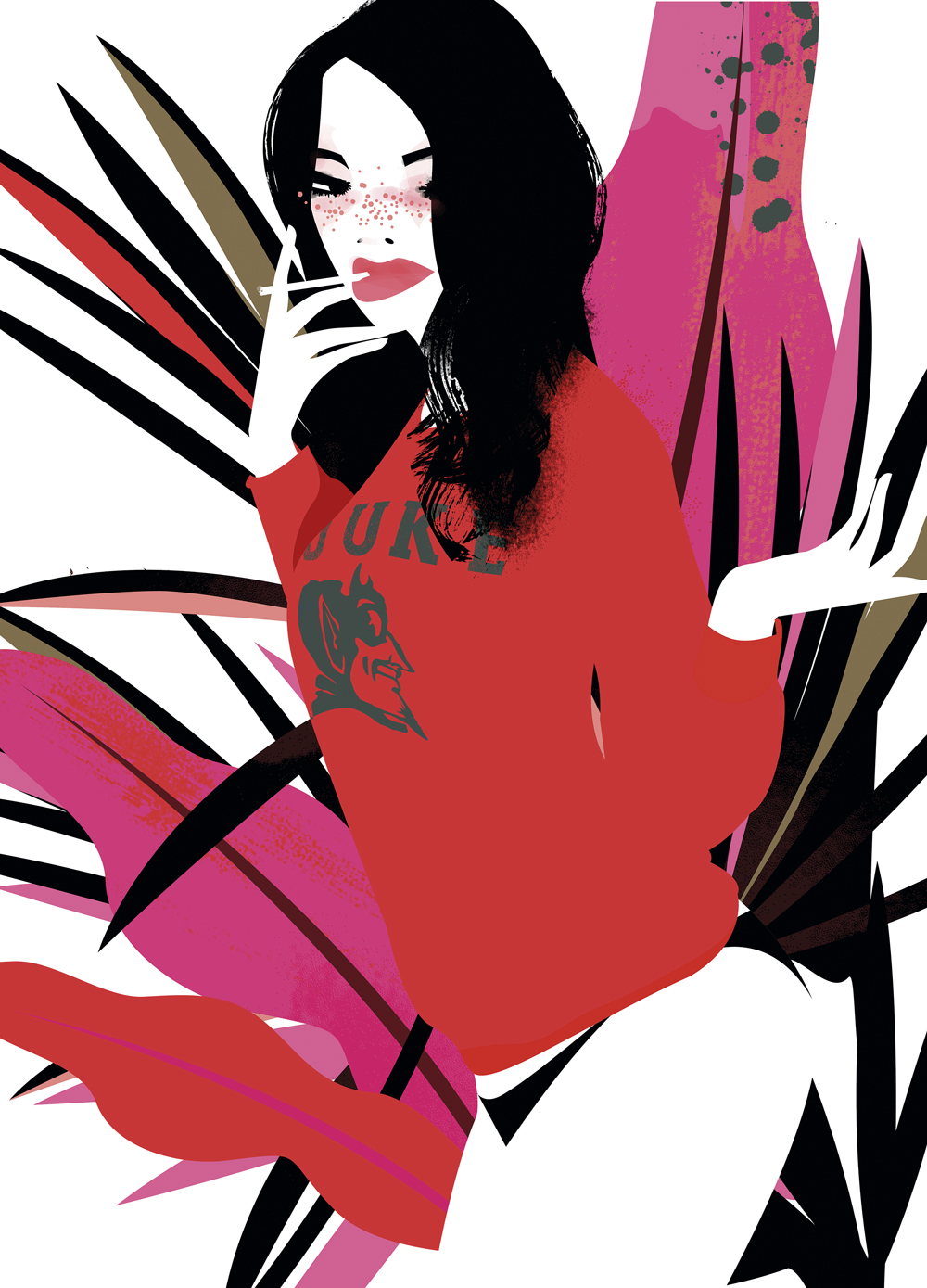
“I love Spain because the urban artists who live in different cities talk and communicate with each other. They are in constantly in contact and carry out common projects that enrich them as creators. This happens less frequently in other countries such as France, for example. Scheduling an exhibition for an artist like Eric [Ceccarini] in the Ibiza gallery is very interesting because then there is a necessary interaction with local art. Since we opened, many artists from the island have passed through Paradiso to introduce themselves and show their work “, says Anna Dimitrova. She continued: “ Me, my Ibicencan gallery and the Paradiso Ibiza were like a UFO, landing in the middle of Cala de Bou. It was something that had never been seen before in this area. I am convinced that the light of the project will also attract the rest of the zone.” It is safe to say that it is already shining brightly.
Terry O’Neil
The persistent, invisible photographer
By Pablo Burgués
All photos: ©Terry O´Neill / Iconic Images / courtesy MONDO
Once upon a time there was a young Englishman called Terry O’Neill who wanted to become a jazz drummer. It was the 1950’s, and our Terry dreamed of escaping to New York to learn from the masters of the scene. However Ryanair hadn’t been invented yet, and the tickets were way too expensive for him.
One cold morning, while he was eating his breakfast of baked beans and tea, he had the bright idea of becoming an air steward so that he could fulfil his dream of going to New York, for free. He got in touch with an airline who told him that getting a job in the airline’s technical photographic unit would help his chances of getting an air steward’s job, So O’Neill joined this department as a trainee. He took regular courses at art school and this awakened his interest in photojournalism.
One day as Young Terry was walking through Heathrow Airport he came across an elegant-looking man, wearing a suit and sleeping in the waiting room. The gentleman was surrounded by a group of Africans Chieftains, complete in full regalia, and the situation was so unique that he decided to take a photo.
The man in question was in fact Rab Butler, the British Home Secretary, and the photo, which ran in the papers soon after, was so successful that O’Neill was instantly inundated with work and he began working at popular London tabloid called The Daily Sketch. Overnight the drummer had become a photographer.
At the beginning of the 1960’s, photographers still worked with large and unwieldy cameras. Given the nature of the assignments O’Neill worked on, he couldn’t haul one of these cameras around so he went to a market and bought a 35mm camera, without knowing that this cheap tool of his would end up converting him into a legendary photographer.
The camera’s small format and ease of use allowed him to move silently around his subjects, making him invisible, and achievachieving relaxed, natural images of a type that had never been seen before.
Moving onto 1963, he took some photos of a group you may have heard of: The Beatles. The photos were taken in the courtyard of Abbey Road Studios, where the group where recording their debut album. These photos were so damn cool that they became some of the first photos of a rock band to be published in the press.
They also brought him to the attention of some the most popular artists in the world and he soon began taking pictures of the big hitters including: The Rolling Stones, David Bowie, Led Zeppelin, Elvis Presley, Elton John, Bruce Springsteen and Frank Sinatra. Frank loved Terry’s work so much that they continued to work together over the next 30 years.
Another thing that makes O’Neill such a legend is the fact that he is extremely persistent. Before shooting his subject with his camera, he would often spend days or weeks with the artist, so much so that they ended up becoming friends with him. This in turn made the subject relax when in his presence, allowing for spontaneous and informal photos.
So we’ve reached the end of this little story about Terry O’Neill, a man who never achieved his dream of being a jazz drummer, but who, with his photos, converted a group of unknown kids into some of the biggest rock ‘n’ roll legends of all time. We at Concept Hotel Group are eternally grateful for this, and as a tribute, three of his most iconic photos will grace the walls of our Dorado Hotel forever and ever: The Beatles in the Abbey Road Studios courtyard (Room 409), Bruce Springsteen walking on Sunset Boulevard (Room 403) and Queen in one of their first studio sessions (Room 405).








